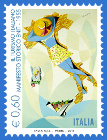Walking through the "streets" of Venice

A regular Venetian street is called calle, a Venetian term for the Italian strada or via, while a square is called campo or campiello. They have an antique, mysterious and romantic flavour. In the past the main door of the buildings opened on the side of the canal, and was reached by a jumper once the boat was parked. There was no need to travel on the roads and the streets were only spaces between the houses, often narrow and twisted. An example? In one of the narrowest streets near the New Foundations (in the north part of the lagoon of Venice), you can walk only on one side, as it is large... only 53 centimetres. It is worth to visit it and take a picture! However, the average width of a street is 5-6 meters, while the length varies from a few meters to a hundred.
The names of the calle are particular. They are culled from the noble family who lived in a palace in the area (Calle Foscarini), some from a church, a monastery or an altar nearby (Calle della Madonna), others on activities or crafts that were practiced there (Calle del falegname ). There are also calli with the same name located in different districts (sestrieri), mostly in Venetian dialect and therefore incomprehensible to tourists!
It is very easy to get lost in these alleys, but the experience is great. Should you cruise without a precise destination, you could discover narrow, quiet and suggestive calle, where the sun never gets, whose end is... a channel. These calle are full of history, charm and secrets, of noble women in beautiful damask dresses decorated with ribbons and laces, of Casanova. An uncomparable maze that only Venice can offer, should you be on your honeymoon or vacation.
In the past Venice was scarcely lit at night and it was not safe walking through the city because you could have unpleasant encounters, for example criminals and pranksters who cut the nobles’ clothes. Therefore it was decided to illuminate the roads with oil lamps. But it was not enough. People were afraid to move all the same. As everybody was compelled to carry a lamp after sunset, a new profession origined at the time: the “codega”, a sort of night-guide, who used to bring people back home with his lamp.
In 1732, however, Venice was illuminated with more than 800 public lamps and soon the codega remain without work.
Today the streets of Venice are full of houses and palaces, but not only. In order to enter the spirit and atmosphere of this charming city you can look for handcrafted shops, boutiques, and small but very characteristic places where to stop for a drink or a coffee before flowing into Piazza San Marco, one of the finest squares in the world, where you can admire St. Mark’s Campanile and the Doge's Palace in all their majesty.
If you are in Venice, you’d better visit also other Venetian cities in the eastern Adriatic, Chioggia, Burano, Murano, Caorle, Venice and Grado. There you will find other wonderful and little roads called calle as well.













